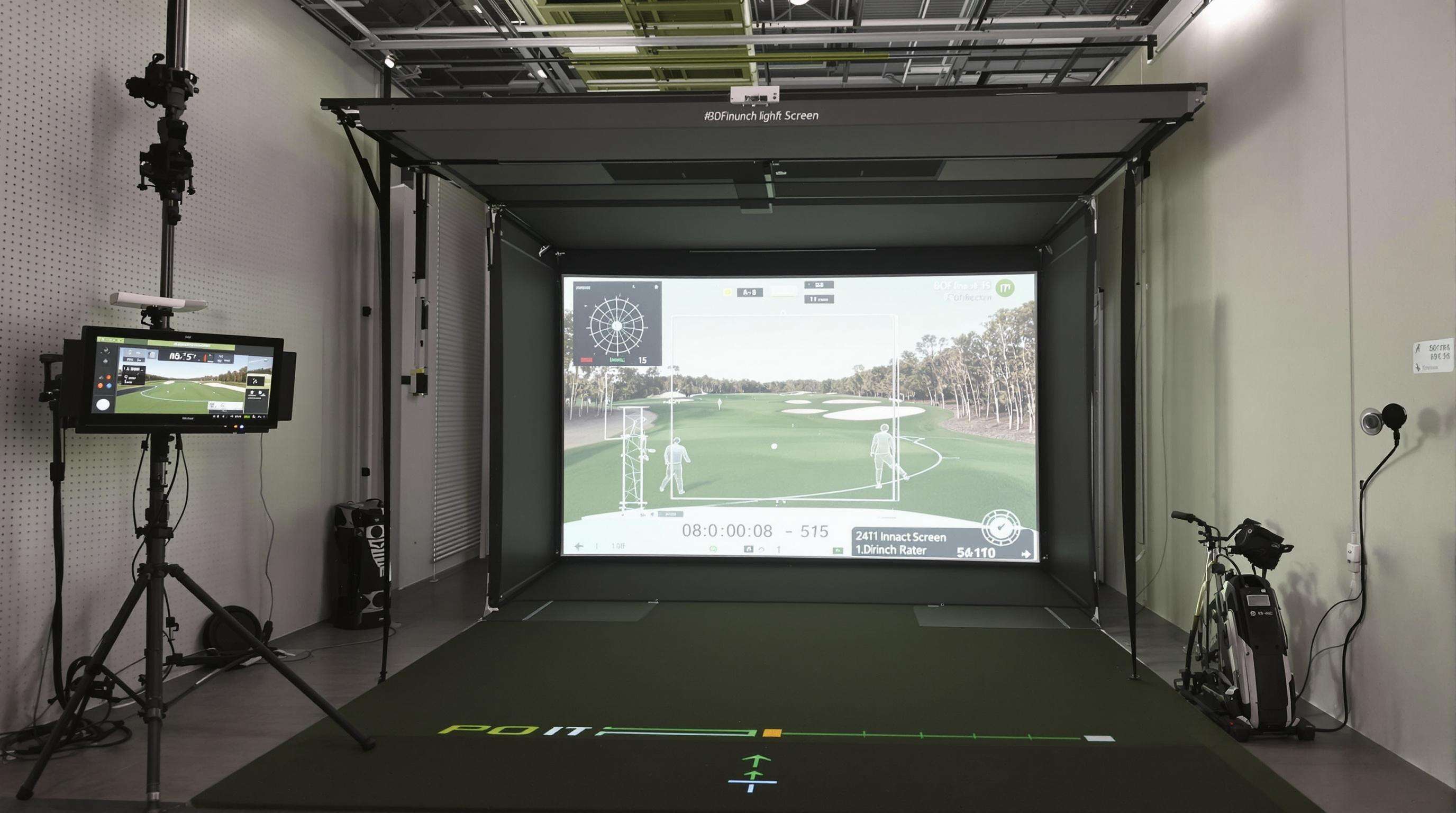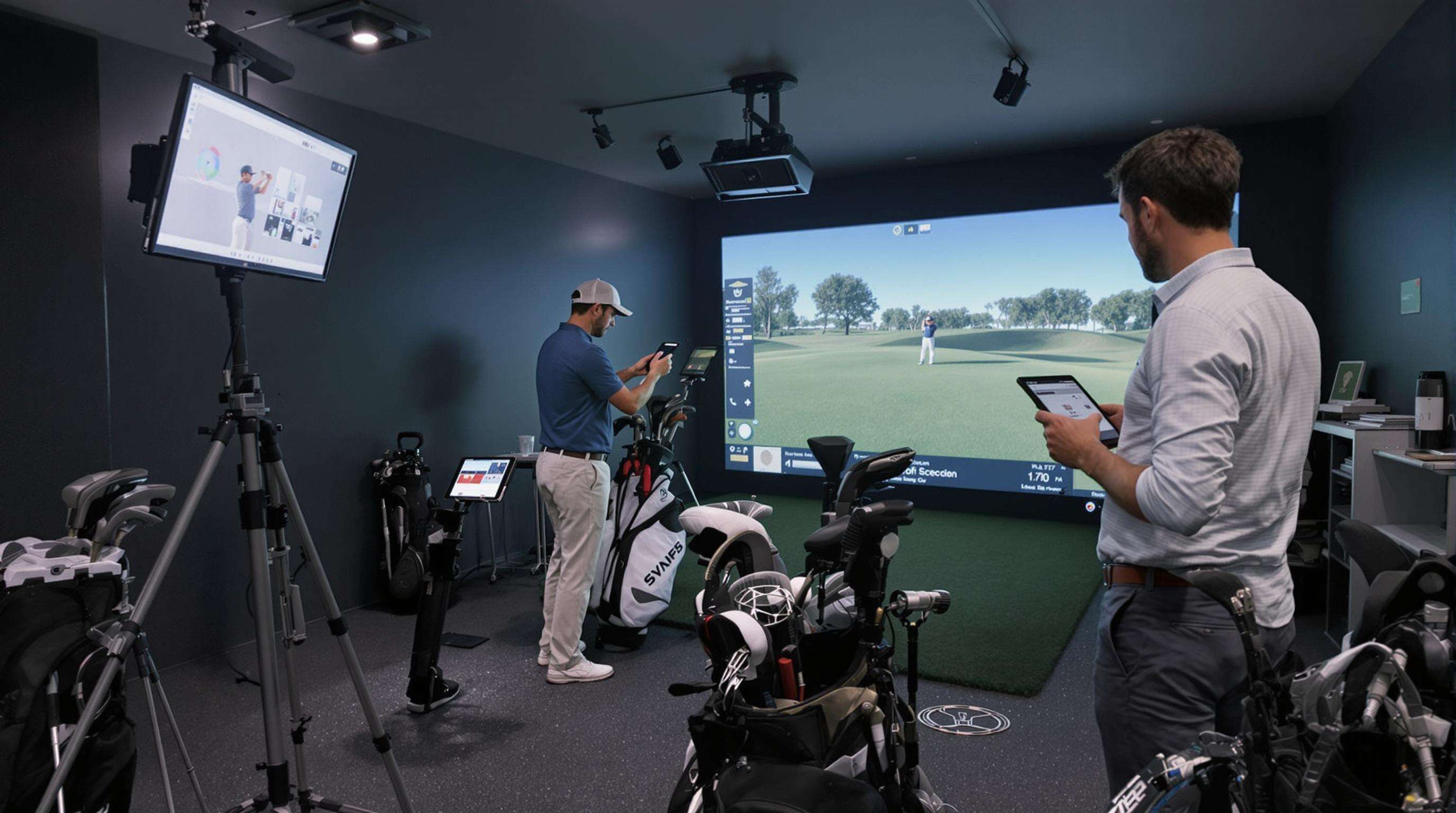Porozumění Swing Screen stroj Použití
Swingové obrazovky propojují trénink golfu v interiéru a profesionální simulace, vytvářejí imersivní prostředí, která napodobují podmínky skutečných hřišť. Tyto systémy slouží hráčům všech úrovní dovedností, od příležitostných nadšenců po elitní soutěživost. Výběr optimálního řešení vyžaduje posouzení tří základních rozměrů: standardů výkonu, prostorové logistiky a rozvoje dovedností.
Trénink golfu vs. požadavky profesionální simulace
Domácí trénink vyžaduje dostupnost a uživatelsky přívětivá měření, jako je rychlost míče nebo úhel odpalu. U přenosných sítí nebo vyklopných obrazovek je důraz na okamžitou odezvu. Věrohodná profesionální simulace – sítě s certifikací Fédération de Golf, diagnostika pro správné nastavení holejí s integrací Dopplerova radaru. Dále jsme zvýraznili vodící čáry, tlakově citlivý trávník a synchronizaci projektorů z více úhlů u komerčních sestav vhodných pro denní i noční použití. Zatímco domácí zařízení slouží k zábavě, jejich profesionální náhrada se zaměřuje na přesné až milimetrové zobrazení dráhy vašeho swingu.
Prostorové požadavky pro domácí a komerční sestavy
Skládací plátna pro domácnosti Doma se instalace osvědčují v oblastech 10 stop x 10 stop s projektorovými systémy s krátkým dosahem. Komerční zařízení věnují 14–16 stopové prostory na stanici, s bezpečnostními sítěmi upevněnými na stropě. Klíčové rozdíly jsou v volné výšce: 8 stop postačuje pro domácí houpačky, zatímco pro ovládací dráhy jsou zapotřebí stropy o výšce 10 stop a více. Požadavky na větrání se také liší – zařízení s vysokou návštěvností vyžadují investice do systémů vytápění, ventilace a klimatizace (HVAC), zatímco domácí sestavy kladejí důraz na přenosnost.
Zaměření obtížnosti na výběr stroje
Přizpůsobení sofistikovanosti stroje schopnostem hráče zajišťuje nákladově efektivní postup. Začátečníkům prospívají vstupní radary s vizualizací trajektorie v reálném čase. Pokročilým hráčům jsou zapotřebí monitory analyzující úhly nájezdu a odstředivé síly, které zlepšují dovednosti při formování úderů. Elitní uživatelé vyžadují dvojité sestavy s vysokorychlostními kamerami ověřující vlivy nářadí.
Analýza specifikací strojů se spouštěcími plátny

Možnosti integrace spouštěcích monitorů
Bezproblémová integrace monitorovacího systému přeměňuje tréninkové obrazovky na výkonné diagnostické nástroje. Nejlepší rozhraní automaticky synchronizují data, jako je dráha hole a úhel nárazu, bez nutnosti manuální kalibrace a udržují přesnost měření nad 98 % pro rychlost míče a zatočení při použití s technologií Dopplerova radaru.
Materiál nárazové obrazovky a faktory trvanlivosti
Přemium polyesterové hybridy vydrží více než 150 000 nárazů při rychlosti míče 160 mph, než začnou ukazovat známky opotřebení. Komerční obrazovky obsahují vrstvené potahování z polyuretanu o tloušťce 3 mm, které snižuje odraz míče a hlučnost nárazu o 40 % ve srovnání s levnějšími materiály. Verze ošetřené proti UV záření si zachovávají barevnou věrnost po dobu 5 000+ hodin slunečního svitu.
Kompatibilita softwaru a vizualizace dat
Nejlepší řešení zobrazují 3D trajektorii letu míče s přesností ±1 yard vůči okolním podmínkám. Moderní nástroje využívají heatmapy pro analýzu rozptylu nárazů a možnost překrytí výsledků jednotlivých tréninkových sezení.
| Funkce vizualizace | Prospěje | Míra adopce |
|---|---|---|
| Porovnání tréninkových sezení | Sleduje pokrok dovedností | 92 % uživatelů prémiové verze |
| Virtuální průběh kurzu | Zvyšuje zapojení | Zvyšuje čas procvičování o 35 % |
| Analýza úderu | Přesně určuje chyby ve swingu | Snižuje handicap o 3,2 úderu (průměr) |
Synchronizace v cloudu usnadňuje sdílení s trenérem, zatímco integrace API podporuje aplikace třetích stran pro trénink.
Rozpočtové zvážení pro stroje se swingovou obrazovkou
Poměr cena/výkon u vstupních modelů
Modely do 2 500 dolarů obvykle obětují pokročilé funkce, jako je integrace více sportů. Tato řešení mohou postačovat pro rekreační trénink, ale nestačí na profesionální analýzu swingu, často využívají standardizované promítací plochy místo specializovaných nárazových obrazovek.
Dlouhodobá hodnota profesionálních systémů
Profesní zařízení (15 000–50 000 dolarů) mají při správné údržbě až trojnásobnou životnost. Zařízení, která obslouží více než 100 uživatelů týdně, mohou náklady vrátit během 18–24 měsíců prostřednictvím nájemného, přičemž udržují přesnost sledování míče na úrovni přesahující 99,5 %.
Strategie optimalizace uživatelského zážitku

Složitost instalace a nároky na údržbu
Instalace pro domácnosti vyžadují 60–90 minut na základní nastavení, zatímco komerční instalace potřebují profesionální kalibraci. Vyberte si systémy s přístupem ke komponentám bez nástrojů, což usnadňuje údržbu – nárazové plochy vyžadují měsíční čištění a kontrolu zarovnání.
Funkce pro více uživatelů a možnosti přizpůsobení
Systémy ukládající 10+ uživatelských nastavení umožňují okamžité přepínání mezi hráči – klíčové pro provozy s hodinovou propustností. Přizpůsobení zahrnuje výběr virtuálních tratí až po cílené tréninkové moduly zaměřené na konkrétní slabá místa.
Pohledy do odborné metodiky testování
Standardní testovací protokoly v oboru
Testování zahrnuje nárazové zkoušky při rychlostech přesahujících 160 mph a ověření přesnosti proti laserem měřeným kontrolním datům na základě 2 000+ úderů. Zátěžové testy v prostředí ověřují výkon v rozmezí teplot (40°F–100°F).
Interpretace srovnávacích výkonnostních metrik
Klíčové metriky zahrnují:
- Prodleva při zpracování dat : Komerčně využívané systémy dosahují ≤20 ms
- Tolerance odchylky : Modely vyšší třídy udržují přesnost <1,5°
- Hodnocení konzistence : <3 % variabilita při výpočtech rychlosti zatočení
Analýza případů z reálného života
Příběhy úspěšných instalací v domácnostech
Kompaktní sestavy v prostorách pod 350 čtverečních stop udržely plnou rozsahovost swingu a zároveň umožnily instalaci systému pro návrat míče. Uživatelé hlásili 18% zlepšení přesnosti úderů po 40 tréninkových sezeních.
Modernizace technologií otevřených prostorů pro trénink golfu
Komerční zařízení prokázala 22% nárůst příjmů po zavedení simulačně integrovaných swingových obrazovek. Jedna regionální síť dosáhla 41% snížení času potřebného k zaškolení nových golfistů díky okamžité zpětné vazbě o swingu.
Často kladené otázky
Co je swingová obrazovka?
Swingová obrazovka je specializovaný simulační systém navržený tak, aby replikoval podmínky skutečných golfových tratí pro trénink uvnitř prostor.
Čím se liší swingové obrazovky pro domácnosti a pro komerční použití?
Domácí systémy se zaměřují na nízké náklady a zábavu, vyžadují méně prostoru, zatímco komerční sestavy nabízejí pokročilé diagnostické funkce, které vyžadují více místa a údržby.
Jsou vhodné pro začátečníky stroje se swing obrazovkou?
Ano, začátečníci profitují z modelů pro začátečníky, které poskytují vizualizaci dráhy v reálném čase a pomáhají tak zlepšit dovednosti.
Jak se stroje se swing obrazovkou integrují s launch monitory?
Zajišťují bezproblémovou synchronizaci dat s dráhou hole a úhly pro přesnou analýzu výkonu, často využívají Dopplerův radar.

